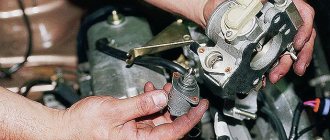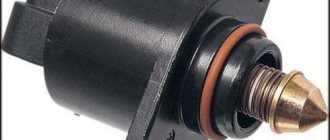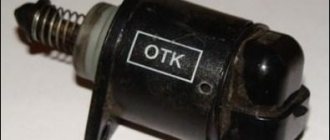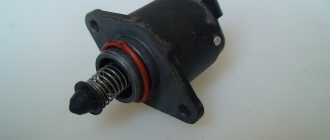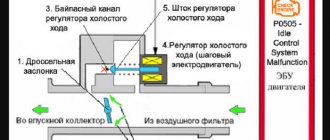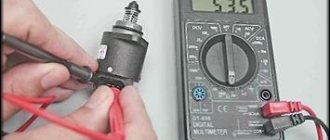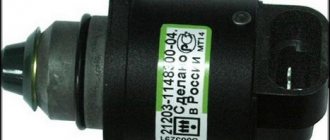General concepts
One of the most common troubles that prevents you from fully driving a car is the idle speed sensor of the VAZ 2110 and modifications.
Although this device is called a sensor among drivers, it will still be correctly called the idle speed controller, abbreviated as IAC, because all automobile sensors are measuring equipment, and this product serves to automatically stabilize and maintain idle speed by supplying air to the engine VAZ 2110 with the throttle valve fully closed. IAC is an important component of the engine and plays a significant role in the stable and uninterrupted operation of any VAZ vehicle.
Idle speed control
The VAZ 2110 idle speed sensor (abbreviated DXX) is an actuator, simply a valve consisting of an electric motor, a spring, and a rod on which a shut-off needle is installed (you can see it in the photo). It is through which the volume of air is dosed. That is, when the throttle of a VAZ 2110, 2112 is completely closed, and the controller determines that the idle speed needs to be increased, the IAC generates a command to change the position of the needle. It moves, partially or completely opening the intake port, through which air bypasses the throttle and then mixes with fuel. As a result, the engine does not stall.
Idle speed sensor for VAZ-2110
Idle speed regulator.
First, let's decide on the catalog number and price of the unit. An idle speed sensor with the original catalog number 2112-1148300 . Its price for 2022 is about 500-550 rubles, depending on the greed of the seller.
By the way, exactly the same regulator is installed on all Priora and Kalina, Tavria, Nanos and Sens.
Be careful not to confuse the sensor we need from below.
How does it work and how does it not work?
The sensor, or idle air control, is designed to dose air into the intake manifold while the throttle valve is closed.
Idle speed sensor disassembled.
The device is not too complicated. It consists of a stepper electric motor, a calibrated spring-loaded cone and a rod. Installed in the intake manifold after the throttle valve . It is this regulator that is responsible for the smooth and smooth operation of the engine at idle speed.
Sensor on the throttle assembly.
Simply put, the idle air control sensor is a simple valve or actuator that controls the air supply when the throttle is closed, according to commands from the electronic engine control unit. When starting the engine in cold weather, the ECU opens the idle speed control slightly and supplies more fuel to the combustion chamber, increasing the speed to speed up the engine warm-up.
Once the engine warms up to operating temperature, the stepper motor moves the conical valve stem forward and reduces the amount of air consumed, thereby reducing the speed. This is how the sensor works.
Signs of sensor malfunction
But it does not work in cases where:
- the engine does not hold idle, the speed fluctuates;
- the engine stalls at idle and when driving in neutral with the throttle closed;
- a cold engine does not start without an open throttle, that is, until we press the gas pedal, the engine will not start;
- low and unstable idle when the engine warms up.
In this case, the Check Engine lamp will not light up . If it lights up, then we look for the cause in the throttle position sensor. In the case where the symptoms are present, but the lamp does not light, the cause should be sought in our sensor. Therefore, now we will check its functionality.
Signs of IAC malfunction
Unfortunately, the 2110 VAZ DXX is not equipped with a self-diagnosis system, so the “CHECK ENGINE” light signal will not indicate a malfunction. Loss of performance on the VAZ 2110, 2112 is determined by the following main features:
- the engine “stalls”, for no apparent reason, at idle;
- idle speed “floats”;
- when a “cold” VAZ 2110, 2112 engine is started, there is no increased speed at all;
- The engine stalls, namely, after turning off the gear while driving.
The symptoms completely coincide with the failure of the VAZ 2110 TPS, but in the case of this sensor the “CHECK ENGINE” indicator will light up.
Differences between a fake and an original
Unfortunately, today you can find a lot of counterfeit products on the automobile market. You can distinguish an original from a fake by a number of criteria.
Counterfeit has the following characteristic features:
- the black metal case is exactly 1 mm shorter;
- There are three white rivets on the body. They don't have hats. Unlike counterfeits, the original has them;
- the counterfeit has a white spring, while the original has a black spring;
- the color of the regulator ring on the fake is black, but in the original it has a reddish tint;
- the counterfeit tip has darker shades compared to the original;
- fakes and originals have external differences in the design of the boxes;
- in the original the yellow sticker is framed. Whoever is counterfeiting this part has overlooked this.
If you are extremely careful, recognizing a fake is not difficult.
How to remove IAC
If signs of malfunction characteristic of the IAC are detected, then it will need to be removed (first for inspection). On the VAZ 2110, this sensor, which is small in size (easily fits in the palm of your hand), is located in a seat on the throttle body (can be seen in the photo).
Removing the idle air control
If necessary, its dismantling is quite easy - it is secured with only two screws. In extremely rare cases, it is necessary to remove the entire VAZ 2110 throttle assembly.
Dismantling is carried out in the following sequence:
- The VAZ 2110 is placed on the handbrake;
- The negative terminal of the battery is disconnected;
- The wiring harness connected to the IAC is disconnected;
- Be sure to clean the connection between the sensor and the throttle body to prevent dirt and rust from getting into the hole;
- Unscrew the fastening screws holding the idle speed sensor of the VAZ 2110.
Idle speed adjustment
It is possible that after replacing the regulator, the idle speed is unstable. This may be due to the fact that the idle speed is off and requires additional adjustment.
Before making adjustments, make sure of the following:
- The battery is fully charged;
- lubricating fluid and coolant are present in the engine in full; if necessary, they are added;
- All vacuum pipes and lines are connected to the power unit;
- complete tightness of the air flow suction system is ensured;
- the cylinders of the power unit have good compression, there are no problematic elements;
- the exhaust gas return system is functioning correctly;
- the throttle valve opens and locks without problems;
- the ventilating device of the engine cooling system is not started.
How to check the sensor?
If you have a tester, checking is easy:
- Set the VAZ 2110 to the handbrake;
- Disconnect the IAC connector to check;
- Check the voltage of the VAZ 2110, 2112 sensor circuit, while connecting the “minus” to the engine, the “plus” to the removed block, namely to terminals A: D (marked on the block, you can see the diagrams);
- The ignition is turned on and the readings given by the idle speed regulator are checked, which should be about 12 V. The value will be less - most likely the battery is discharged. When there is no voltage, it is necessary to check the entire circuit, and then the electronic control unit. There are no malfunctions, which means the circuit is working - the IAC installed on VAZ 2112 engines and other modifications are checked;
- The tester terminals are connected to the block, the circuit is as follows - first to terminals A: B, then to C: D. The resistance should be within 53 Ohms;
- Next, pairs A: C, B: D are checked - in this case, the resistance on a working product will be infinitely large.
IAC diagram
When, as a result of these checks, the sensor reveals a discrepancy in the readings, it should be replaced. Also, the inoperative state of these VAZ 2110, 2112 engine sensors, in the unscrewed position, can be checked by attaching a block to them, then you need to turn on the ignition.
Thanks for subscribing!
When the power is connected to the working product, the rod with the needle will change position. No changes will occur on a broken sensor. If a breakdown of the idle air regulator is detected, of course, it must be repaired. But there is no need to rush to a car service center - you can do the repairs yourself, saving money and time. But first, in general, it is worth cleaning the IACs; often after this they return to “life”.
Checking the sensor yourself
The sensor is located in the throttle body and to remove it for inspection, you just need to unscrew two screws.
To dismantle the IAC, you need to disconnect the block and unscrew two screws.
Before dismantling, you need to thoroughly clean the place of its attachment from dust and dirt and remove the negative terminal from the battery. But first, a check.
Sensor connection diagram.
We look at the connection diagram and check the sensor using a conventional multimeter in the following sequence:
- Check for power supply to the sensor . To do this, measure the voltage at the two outer contacts of the block, A and D. Turn on the ignition, place the black probe of the multimeter on the engine ground, and the positive probe on the contacts one by one. The voltage should be within 12 Volts. If it is less or absent altogether, we look for an open circuit or blame the electronic control unit for everything. But first, we check the voltage at the terminals from ECU 4 and 54. Here, naturally, there should also be 12 V.
The voltage is normal.
It cannot be said that this testing method 100% guarantees the functionality of the sensor; we only checked its electrical part. The mobility of the cone valve and the magnitude of its stroke are of great importance. And this can only be checked either at a special stand or with a special tester.
Checking the operation of the mechanical part of the sensor
To check, remove the sensor from the throttle assembly.
However, if the electrical part is in order, you can check the mechanical part of the regulator by eye:
- Unscrew the sensor and remove it from the throttle body.
- We connect the contact block to the sensor.
- Turn on the ignition. When turned on, the valve should move forward. If this does not happen, the rod is coked or the stepper motor is not working properly.
- We measure the distance between the sensor body and the conical valve - nominal 24 mm.
What could be the sensor malfunctions?
Failures in the functioning of the regulator cause a large number of problems for the car owner.
Accordingly, ignoring the problem for a long time can provoke an accident. Therefore, you should not neglect your own safety and it is advisable to identify the malfunction in the early stages. Signals of a faulty regulator:
- The engine speed constantly fluctuates. You may notice a sudden increase/decrease in this indicator.
- When the engine is cold started, there is no increase in speed.
- When you turn on additional electrical appliances (headlights, stove, etc.), the idle speed decreases noticeably.
- The internal combustion engine stops at idle and when the gear is engaged.
In practice, there are other signs of IAC malfunctions, but in order not to make a mistake and not confuse a sensor malfunction with other failures, it is important to know how the unit in question is checked.
Features of cleaning IAC
To clean, you will need a special carburetor cleaner:
- The block is removed from the regulator, the product is applied to a cotton swab and the contacts are cleaned.
- Then you need to unscrew the regulator fixing bolts, the device is removed from the installation site.
- If there are traces of motor fluid on the body, then in addition to the regulator itself, you will need to clean the throttle. The cleaning agent is sprayed onto the needle with a spring, after which the element must be dried.
Sources
- https://olade.ru/mashiny/vaz-2110/datchik-xolostogo-xoda-vaz-2110.html
- https://topmekhanik.ru/regulyator-hh-vaz-2110/
- https://labavto.com/vaz/2110/remont-i-zamena-datchika-holostogo-hoda/
- https://ladafakt.ru/datchik-rhh-vaz-2110-priznaki-neispravnosti.html
- https://avtozam.com/vaz/2110/datchik-holostogo-hoda-vaz2110/
- https://vaz-2110.ru/elektrika-i-provodka/kak-proverit-i-zamenit-regulyator-holostogo-hoda-na-vaz-2110.html
- https://ladafakt.ru/datchik-holostogo-hoda-vaz-2110-priznaki-neispravnosti.html
Preventive measures
In order not to encounter a complete malfunction of the regulator in the future, it is worth periodically carrying out the cleaning process described above. How often to carry out the cleaning process depends on how actively you use your vehicle. If the car is a work vehicle, it is recommended to check and clean the sensor once a year; if you use it only for yourself, once every two years will be enough. But, of course, do not forget about the signs of a part malfunction; if they appear, do not delay. This will help you avoid complete failure of the part and enjoy a high-quality ride. Together with you, we come to the conclusion that the part is unpretentious, simple in its functionality and use. Don’t forget: timely detection of a malfunction is the key to overall vehicle productivity. The full operation of the engine depends on the serviceability of each of its components, and if you neglect any part, including the idle speed sensor, this can lead to more labor-intensive repair processes and failure of the entire car.
Checking the idle speed sensor
Diagnosing the part is quite easy, but pay attention to a few points. The first problem may be removing the part; most manufacturers attach the XX sensor to screws, and in extreme cases they can be drilled out, but in some variations the part is mounted on varnish
If your regulator is secured with varnish, be careful not to forcefully remove it, as this may damage the intake part of the car. In your case, it would be correct to completely dismantle the throttle assembly and only then disconnect the IAC.
The easiest way to check is, of course, visual inspection.
During a visual inspection, the first thing you should pay attention to is whether the needle is dirty. Also pay attention to the condition of the contacts and the throttle valve itself.
If broken wires are found, they must be returned to their place. Solder them and, to avoid corrosion, treat them with varnish.
It would be appropriate, if possible, to check the IAC with a multimeter or a homemade tester. You can check the resistance with a multimeter, and use a homemade tester (you can make one from a mobile phone charger) to check the stroke of the regulator rod.
If you find that the motor is damaged, the rod is completely worn out, or the cone needle is worn out, the part will need to be replaced. Don’t be too upset about this, the cost of the part will only be about 1000 rubles.
Causes of failure. Node check
The reasons for the malfunction of the XX regulator are breaks in the electrical winding. engine and needle jamming due to dirt or corrosion. But the sensor is not always the “culprit” for missing idle speed. Therefore, before removing and checking the sensor, check its power supply circuit.
For all checks you will need a multimeter. The power circuit is checked with a device set to “voltmeter” mode. Diagnostics is simple - we disconnect the block with wires from the regulator, connect the “negative” probe of the multimeter to ground, and the positive one to the terminals marked with the letters “A” and “D”. With the ignition on, we take measurements. If the circuit is working properly, the readings should correspond to the rated voltage of the circuit. If there is no voltage, you should check the computer and relays responsible for powering the sensor.
Checking the serviceability of the IAC
Initially, put the car on the handbrake and place wheel chocks under the wheels. Next, gain access to the device, disconnect it from the supply wire block. The next step is to check the voltage using a regular voltmeter. Contacts to be checked: minus of the internal combustion engine and plus on the contacts of the wire block A, D.
To perform a proper check, turn on the ignition and evaluate the information you receive. The voltage on the device should be no more than 12 Volts. If the indicator is less, then there may be problems with the battery. If there is no voltage at all, then you need to check the electronic control unit and the entire circuit.
Next, carry out the inspection with the ignition on. Check pins A:B, C:D. The optimal resistance should be around 53 ohms. With the sensor removed and the ignition on, if you connect a power supply to it, the conical needle should move. If nothing like this happens, the node is faulty.
Otherwise, the malfunction lies in the operation of the regulator, but do not panic and immediately go to a service station. You can replace the unit in question or clean it yourself.
Step-by-step replacement procedure
The replacement procedure is carried out in almost the same way as cleaning the device, but there are certain nuances:
- The battery is disconnected to prevent a short in the wiring.
- The plug with the electrical circuit is disconnected from the control device. If the car is equipped with an injection power unit, then to disconnect the connector you need to press on the plastic fastener.
- The bolts are unscrewed. As when cleaning, first unscrew the left fastener, and then the right one. The failed regulatory device is being dismantled.
- The surface on which the sealing element is mounted is also cleaned. The latter is checked for defects - abrasions, cracks, etc. If they are present, the sealing gum is replaced with a new one. Before installation, the seal is treated with engine fluid, after which it is mounted on the throttle seat.
- The controller is installed, a connector with wires for its power supply is connected. A wire is connected to the battery.
- After installation, a calibration procedure is performed. The microprocessor module must perform this independently; an electronic relay is used for this. To calibrate the new sensor, the ignition is turned on for a few minutes and then turned off. If the actions performed helped and the speed no longer floats, but remains at the same level, then the replacement procedure can be considered complete.
What do you need to know when replacing the IAC?
To change and install a controller that allows you to regulate idle speed, you need to pay attention to the position of the rod. It must not be allowed to be pushed forward too much. This can happen if the device is connected to the block and the ignition is activated before installation. It is not allowed to push the rod in by hand.
If the valve is installed with the needle extended and the retaining screws are tightened, damage to the unit may occur due to shearing of the worm gear. It is impossible to repair such a sensor. Depending on the vehicle model, after installing a new regulator, it may need to be calibrated. In some cars, this procedure is carried out using special equipment or a stand.
On VAZ cars, calibration is performed as follows:
- A terminal is connected to the negative output of the battery.
- The key is turned in the lock to turn on the ignition for ten seconds. There is no need to start the power unit.
- The ignition is turned off.
Learning to distinguish a fake from an original
Today, many people complain about the abundance of counterfeit products on the auto parts market.
If we talk specifically about the XX regulator for the VAZ 2110, then there are several key signs by which a fake can be distinguished from the original. Be guided by these data so as not to accidentally install a device of dubious quality and origin on your car.
Fake and original
- On fakes, the black body made of metal is 1 millimeter shorter than the real part.
- In the case of the fake, the three white rivets on the case have no heads. They must be present in the original. And the diameter of the caps is 3 millimeters.
- On fakes, the spring is made in white and has more frequent winding. In the original, the coiling is less frequent, and the spring itself is black.
- Pay attention to the rubber ring of the regulator. On fakes it is black and thin, but in the case of a real part, a reddish tint is noticeable. Plus the thickness is greater.
- Take a closer look at the tip. In fakes it is darker compared to the original spare part.
- There are no markings on the counterfeit packaging; the boxes are noticeably different in appearance.
- The original yellow sticker located on the case must have an outer frame. Manufacturers of counterfeits apparently forgot about it.
As you can see, recognizing a fake is not difficult. You just need to be more attentive to details.
The difference is in the boxes
Choosing a replacement regulator
On the VAZ-2110 with both 8-valve and 16-valve injection engines, a sensor with catalog number 2112-1148300 is used. Additionally, at the end of the marking there is a prefix consisting of two numbers, for example, 01, 02, 03, 04. This index indicates the manufacturer of the regulator (01 and 03 - “Pegasus”, 02 and 04 - KZTA). When choosing a replacement regulator, pay attention to two nuances - the seal and the height of the needle protrusion above the body. Factory spare parts use a red seal, while counterfeits use a black rubber element. The height of the needle protrusion above the body is 23 mm.
Before installing a new regulator, it is recommended to coat the sealing ring with a thin layer of engine oil to ensure a tight fit of the part in the seat and eliminate the possibility of air leaks.
Video: Review of VAZ idle speed controllers
Source

